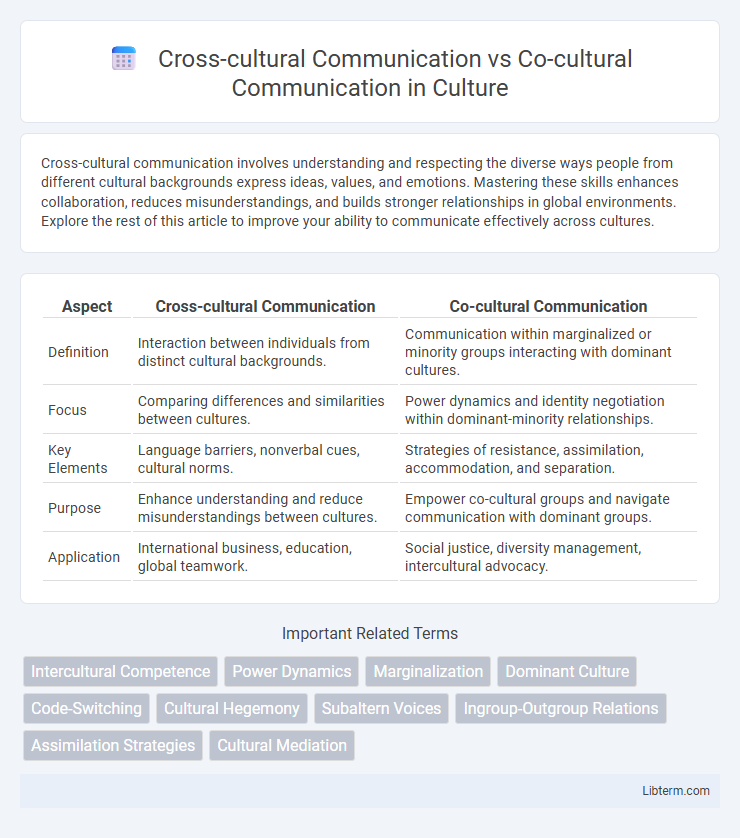Cross-cultural communication involves understanding and respecting the diverse ways people from different cultural backgrounds express ideas, values, and emotions. Mastering these skills enhances collaboration, reduces misunderstandings, and builds stronger relationships in global environments. Explore the rest of this article to improve your ability to communicate effectively across cultures.
Table of Comparison
| Aspect | Cross-cultural Communication | Co-cultural Communication |
|---|---|---|
| Definition | Interaction between individuals from distinct cultural backgrounds. | Communication within marginalized or minority groups interacting with dominant cultures. |
| Focus | Comparing differences and similarities between cultures. | Power dynamics and identity negotiation within dominant-minority relationships. |
| Key Elements | Language barriers, nonverbal cues, cultural norms. | Strategies of resistance, assimilation, accommodation, and separation. |
| Purpose | Enhance understanding and reduce misunderstandings between cultures. | Empower co-cultural groups and navigate communication with dominant groups. |
| Application | International business, education, global teamwork. | Social justice, diversity management, intercultural advocacy. |
Introduction to Cross-cultural and Co-cultural Communication
Cross-cultural communication examines interactions between individuals from different cultural backgrounds, emphasizing language, customs, and values that influence understanding and behavior. Co-cultural communication focuses on conversations within marginalized or minority groups as they navigate dominant societal norms, highlighting power dynamics and identity negotiation. Both fields study how cultural contexts impact message creation and interpretation, enhancing effective communication across diverse social environments.
Defining Cross-cultural Communication
Cross-cultural communication refers to the interaction between people from different cultural backgrounds, emphasizing understanding diverse cultural norms, values, and communication styles to avoid misunderstandings. It involves analyzing how cultural differences impact verbal and nonverbal communication in international, intercultural, or multicultural contexts. Unlike co-cultural communication, which examines communication within marginalized or less dominant groups inside a larger society, cross-cultural communication focuses on bridging communication gaps across distinct cultural groups globally.
Understanding Co-cultural Communication
Understanding co-cultural communication involves recognizing how marginalized or non-dominant groups interact within a dominant cultural framework, emphasizing adaptive strategies like assimilation, accommodation, and separation. This communication process highlights power dynamics, identity negotiation, and the need for mutual respect in multicultural settings. Effective co-cultural communication skills enhance inclusivity, reduce misunderstandings, and foster equitable dialogue across diverse social groups.
Key Differences between Cross-cultural and Co-cultural Communication
Cross-cultural communication involves interactions between individuals from distinctly different cultural backgrounds, emphasizing differences in language, customs, and social norms across national or ethnic groups. Co-cultural communication, on the other hand, focuses on communication within a dominant culture where smaller cultural groups share common societal spaces but maintain unique identities, such as minority groups within a country. Key differences lie in scale and scope: cross-cultural communication bridges wholly separate cultures, while co-cultural communication navigates power dynamics and identity within a shared dominant cultural framework.
Theoretical Foundations of Each Approach
Cross-cultural communication theory emphasizes interactions between individuals from distinctly different cultural backgrounds, grounded in frameworks such as Hofstede's cultural dimensions and Hall's context theory to explain variations in communication styles. Co-cultural communication theory focuses on the communication strategies used by marginalized or non-dominant groups within a dominant culture, drawing from Mark Orbe's co-cultural theory which highlights factors like preferred outcomes, communication styles, and situational context. Both approaches explore power dynamics and identity but differ in their scope; cross-cultural communication addresses intergroup exchanges broadly while co-cultural communication specifically analyzes marginalized group interactions within a dominant societal framework.
Common Barriers in Cross-cultural and Co-cultural Contexts
Common barriers in cross-cultural and co-cultural communication include language differences, which create misunderstandings and misinterpretations between individuals from distinct cultural or social groups. Stereotyping and ethnocentrism lead to biased perceptions and hinder effective interaction by promoting preconceived notions about other cultures or subcultures. Power dynamics and social hierarchies often exacerbate communication challenges, as marginalized co-cultural groups may face discrimination and limited opportunities to express their perspectives.
The Role of Power Dynamics in Communication
Power dynamics significantly influence both cross-cultural and co-cultural communication by shaping which voices are heard and whose perspectives dominate interactions. In cross-cultural communication, disparities in cultural norms and societal hierarchies often exacerbate misunderstandings and reinforce inequalities between dominant and marginalized groups. Co-cultural communication specifically examines how individuals from marginalized communities negotiate power imbalances to assert their identities and effectively communicate within dominant cultural frameworks.
Practical Strategies for Effective Cross-cultural and Co-cultural Interaction
Effective cross-cultural communication requires active listening, cultural empathy, and adaptation to diverse nonverbal cues, enabling meaningful exchanges between individuals from different cultural backgrounds. In co-cultural communication, recognizing power dynamics, shared experiences, and in-group language fosters solidarity and mutual understanding within marginalized or minority groups. Practical strategies include developing intercultural competence through ongoing education, practicing perspective-taking, and employing clear, inclusive language to bridge cultural divides and enhance collaborative interactions.
Case Studies: Real-world Examples and Outcomes
Case studies on cross-cultural communication reveal how multinational corporations improve collaboration by adapting to diverse cultural norms, resulting in increased productivity and reduced conflicts. In contrast, co-cultural communication research highlights marginalized groups within dominant societies navigating power dynamics, with successful outcomes including enhanced social inclusion and identity affirmation. Both approaches provide critical insights into effective strategies for managing cultural diversity in workplace and community settings.
Conclusion: Integrating Cross-cultural and Co-cultural Insights
Integrating cross-cultural and co-cultural communication insights enhances understanding by addressing both broad cultural differences and the nuanced experiences of subordinate groups within cultures. This comprehensive approach fosters more effective interaction, reduces misunderstandings, and promotes inclusivity in diverse social and professional environments. Emphasizing both frameworks prepares individuals to navigate global multicultural contexts with greater empathy and adaptability.
Cross-cultural Communication Infographic

 libterm.com
libterm.com